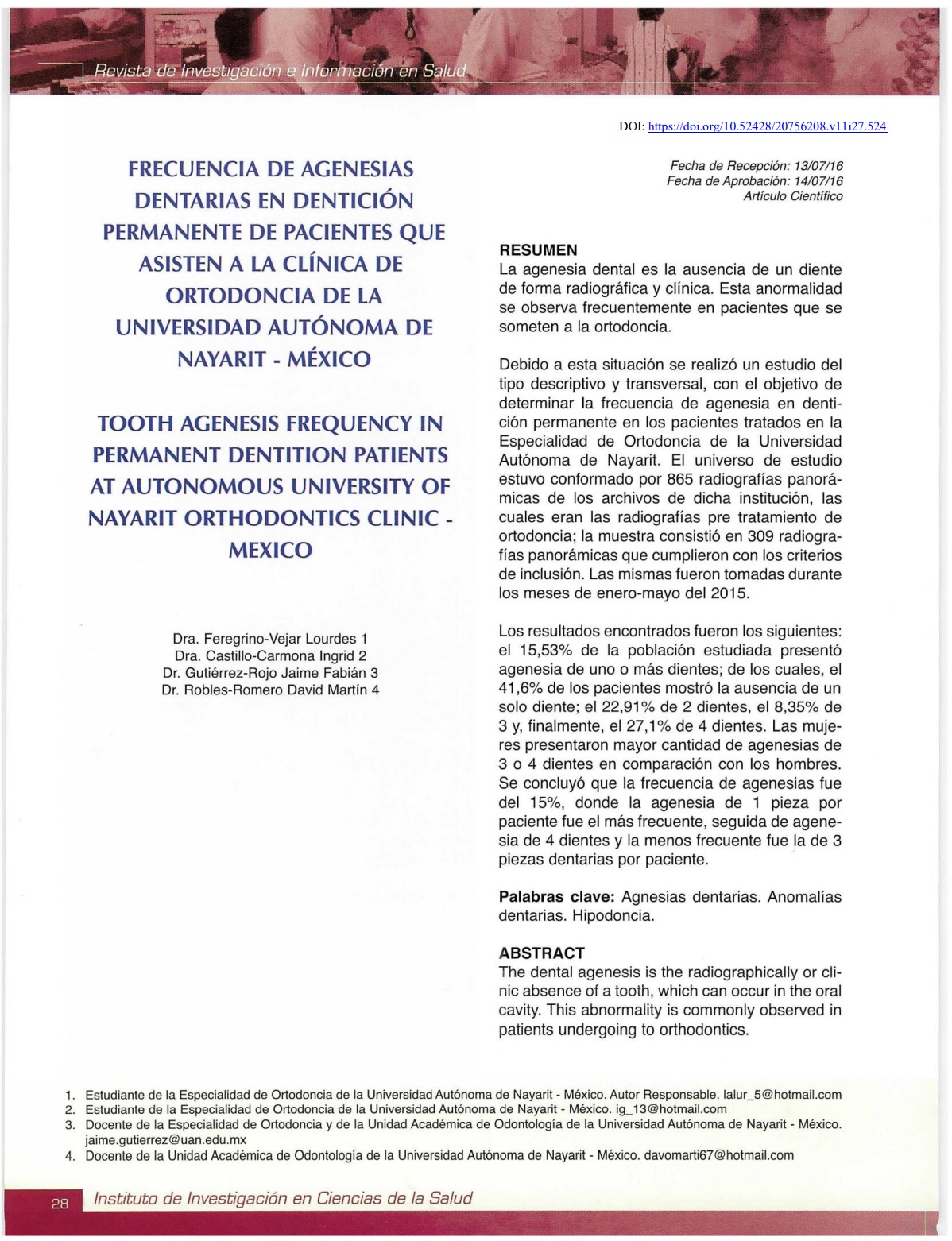Tooth Agenesis Frequency in Permanent Dentition Patients at Autonomous University of Nayarit Orthodontics Clinic Mexico
DOI:
https://doi.org/10.52428/20756208.v11i27.524Keywords:
Tooth agenesis, Dental anomalies, HypodontiaAbstract
The dental agenesis is the radiographically or clinic absence of a tooth, which can occur in the oral cavity. This abnormality is commonly observed in patients undergoing to orthodontics. Because of this situation, a descriptive and transversal study was conducted in order to determine the frequency of agenesis in permanent dentition in patients treated in the Specialty of Orthodontics at the Autonomous University of Nayarit. The study group consisted of 865 panoramic radiographs from files of the institution, which were pretreatment orthodontic radiographs; the sample consisted of 309 panoramic radiographs that met the inclusion criteria. The results were as follows: 15,3% of the study population presented agenesis of one or more teeth; of which 41 ,6% of patients showed the absence of a single tooth; 22,91% 2 teeth; 8,35% of 3 and finally 27; 1% 4 tooth. Women had a higher number of agenesis of 3 or 4 cloves compared to men. lt was concluded that the frequency of agenesis was 15%, where agenesis of 1 part per patient is the most common, followed by 4 teeth and the least frequent was 3 pieces teeth per patient.
Downloads
References
1. CHAPPUZEAU E, CORTÉS D. Anomalías de la dentición en desarrollo: Agenesias y supernumerarios. Revista Dental de Chile. 2008; 99 (2): 3-8.
2. IGLESIAS P, MANZANARES M, VALDIVIA 1, ZAMBRANO R, SOLÓRZANO E, TALLÓN V, CARVALHO P. Anomalías dentarias: prevalencia en relación con patologías sistémicas en una población infantil de Mérida, Venezuela. Revista Odontológica de los andes. 2007 2 (2); 37-50.
3. VELLINI F. Ortodoncia Diagnostico y Planificación Clínica. 1 ra edición. Editorial Artes Medicas Latinoamérica. Sao Paulo. 2002; 98-114; 233-252.
4. GARCÍA-HERNÁNDEZ F, BELTRÁN VJ. Agenesia del tercer molar en una etnia originaria del Norte de Chile: Atacameños o Lican Antai. lnt. J. Morphol. 2008; 26 (3): 583-90. https://doi.org/10.4067/S0717-95022008000300013
5. CARBAJAL EE, MARTÍNEZ BA, VÁZQUEZ DJ. Oligodoncia: estudio radiográfico de un caso clínico. Acta odontológica Venezolana [Internet]. 2008 [consultado el 6/06/2015]; 46 (3). Encontrado en: http://www.actaodontologica.com/ediciones/2008/3/pdf/oligodoncia_estudio_radiografico.pdf.
6. KOLENC FJ. Agenesias dentarias: en busca de las alteraciones genéticas responsables de la falta de desarrollo. Med Oral Patol Oral Cir Bucal. 2004; 9 (): 385-95.
7. ARBOLEDA LA, ECHEVERRI J, RESTREPO LA, MARÍN ML, VÁSQUEZ G, GÓMEZ JC, et al. Agenesia Dental. Revisión bibliográfica y reporte de dos casos clínicos. Rev Fac Odontol Univ Antioq. 2006; 1 8 (1): 47·54.
8. HÓLTTA P, ALALUUSUA S, SAARINEN-PIHKALA UM, PELTOLA J, HOVI L. Agenesis and microdontia of permanent teeth as late adverse etfects alter stem cell transplantation in young children. Cancer. 2005; 103 (1): 181-190. https://doi.org/10.1002/cncr.20762
9. VASTARDIS H. The génesis of human tooth agenesis: New discoveries for understanding dental anomalíes. Am J Orthod Dentofacial Orthop. 2000; 1 1 7 (6): 650·6. https://doi.org/10.1016/S0889-5406(00)70173-9
10. ESPINAL G, MANCO HA, AGUILAR G, CASTRILLÓN L, RENDÓN JE, MARÍN ML. Estudio retrospectivo de anomalías dentales y alteraciones óseas de maxilares en niños de cinco a catorce años de las clínicas de la Facultad de Odontología de la Universidad de Antioquia. Rev Fac Odontol Univ Antioq 2009; 21 (1 ): 50·64.
11. PONCE S, LEDESMA C, SANCHEZ G, MORALES 1, GARCÉS M. Anodoncia no sindrómica. Estudio clínico-radiográfico. Revista ADM. 2004; LXI (5): 171-175.
12. GAMBA D, ALENCAR BM, PEREIRA JR, BACCETTI T. Agenesis of maxillary lateral incisors and asociated dental anomalies. Am J Orthod Dentofacial Orthop. 2010; 137 (6):732.e1-e6. https://doi.org/10.1016/j.ajodo.2009.12.024
13. RUIZ-MEALIN E, PAREKH S, JONES SP, MOLES DR, GILL DS. Radiographic study of delayed tooth development in patients with dental agenesis. Am J Orthod Dentofacial Orthop. 2012 ; 141 (3):307 -14. https://doi.org/10.1016/j.ajodo.2011.08.026
14. TAVAJOHl·KERMANI H, KAPUR R, SCIOTE JJ. Tooth agenesis and craneofacial morphology in an orthodontic population. Am J Orthod Dentofacial Orthop. 2002; 122 (1): 39-41. https://doi.org/10.1067/mod.2002.123948
15. PECK S, PECK L, KATAJA M. Site-specificity of tooth agenesis in subjects with maxillary canine malpositions. Angle Orthod. 1996; 66 (6): 413 -6.
16. Richardson M. Late third molar génesis: lts significance in orthodontic treatment. The Angle Orthodontist. 1980; 50 (2): 121·8.
17. RI CHARDSON ME. Sorne aspects of lower third molar eruption. The Angle Orthodontist. 1974; 44 (2): 141 ·5.
18. MONCUNILL J, RIVERA A. Puesta al día sobre el tercer molar inferior. Implicaciones en el trata· miento de ortodoncia. Ortodoncia clínica. 2008; 11 (4): 180-4.
19. DÍAZ·PÉREZ R, ECHAVERRY-NAVARRETE RA. Agenesia en dentición permanente. Rev. Salud pública. 2009; 11 (6): 961-969. https://doi.org/10.1590/S0124-00642009000600012
20. Bastidas MA, Rodríguez AM. Agenesia dental en pacientes jóvenes. Revista Estomatología. 2004; 1 2 (2): 34-43. https://doi.org/10.25100/re.v12i2.5568
21. LOAIZA YJ, CÁRDENAS G. Prevalencia e interpretación radiográfica de la agenesia dentaria en el área de influencia del servicio de ortopedia dentofacial en la facultad de odontología de la universidad de Carabobo. Revista ODOUS Científica. 2001; 2 (2): 1-23.
22. HARRIS EF, CLARK LL. Hypodontia: an epidemiologic study of American black and White people. Am J Orthod Dentofacial Orthop. 2008; 134 (6):761-7. https://doi.org/10.1016/j.ajodo.2006.12.019
23. POLDER BJ, VAN'T HOF MA, VAN DER LINDEN FP, KUIJPERS-JAGTMAN AM. A meta-analysis of the prevalence of dental agenesis of permanent teeth. Community Dent Oral Epidemial 2004; 32: 217-26. https://doi.org/10.1111/j.1600-0528.2004.00158.x
24. ENDO T, OZOE R, KUBOTA M, AKIYAMA M, SHIMOOKA S. A survey on hypodontia in Japanese orthodontic patients. Am J Orthod Dentofacial Orthop 2006; 129 (1):29-35). https://doi.org/10.1016/j.ajodo.2004.09.024
25. DUQUE AM, ESCOBAR S. Anomalías dentarias de numero agenesia, hipodoncia y oligodoncia reporte de casos. Revista Estomatología. 2002; 10 (1): 32-8. https://doi.org/10.25100/re.v10i1.5527
26. LAGOS D, MARTÍNEZ AM, PALACIOS JV, TOVAR D. HERNÁNDEZ JA, JARAMILLO A. Prevalencia de anomalías dentarias de número en pacientes infantiles y adolescentes de las clínicas odontológicas de la Universidad del Valle desde el 2005 hasta el 2012. Rev Nac Odontol. 2015; 11(20):31-39. https://doi.org/10.16925/od.v11i20.940
27. TORRE MR. Frecuencia de ausencias congénitas y dientes supernumerarios del posgrado de ortodoncia de la UANL. Tesis para obtener el grado de Maestría en ciencias odontológicas con especialidad en ortodoncia. Universidad Autónoma de Nuevo León. Nuevo León. 2010. 36-7, 41.
28. SILVA R. Radiographic assesment of congenitally missing teeth in ortodontic patients. lnt Paediatr Dent. 2003; 13 (2): 112-6. https://doi.org/10.1046/j.1365-263X.2003.00436.x
29. CUAIRÁN V, GAITÁN LA, HERNÁNDEZ AJ. Agenesia dental en una muestra de pacientes ortodonticos del hospital Infantil de México. 1996; LIII (4): 211-5.
30. GARCÍA-HERNÁNDEZ F, TORO O, VEGA M, VERDEJO M. Agenesia del tercer molar en jóvenes entre 1 4 y 20 años de edad, Antofagasta, Chile. lnt. J. Morphol.2008; 26(4):825-832. https://doi.org/10.4067/S0717-95022008000400008
31. AGURTO-GOYA H, TANAKA S, MAEDA T, AKIMOTO Y. An orthopantomographic study of hypodontia in permanent teeth of Japanese pediatric patients. European Journal of orthodontics. 2008; 30 (2008): 641-4.
32. ALCÁNTARA C. Prevalencia y distribución de agenesias dentarias y dientes supernumerarios en pacientes de 7 a 18 años de edad atendidos en el Centro Médico Naval. Enero 2003-Julio 2004. Tesis para optar por el título de cirujano dentista. Universidad Nacional Mayor de San Marcos. Lima. 2005:31-5.

Downloads
Published
How to Cite
Issue
Section
License
Copyright (c) 2016 Lourdes Feregrino Vejar , Ingrid Castillo-Carmona , Jaime Fabián Gutiérrez-Rojo y David Martín Robles Romero

This work is licensed under a Creative Commons Attribution 4.0 International License.
Authors who publish with this journal agree to the following terms:
- Authors retain copyright and grant the journal right of first publication with the work simultaneously licensed under a Creative Commons Attribution License 4.0 that allows others to share the work with an acknowledgement of the work's authorship and initial publication in this journal.
- Authors are able to enter into separate, additional contractual arrangements for the non-exclusive distribution of the journal's published version of the work (e.g., post it to an institutional repository or publish it in a book), with an acknowledgement of its initial publication in this journal.
- Authors are permitted and encouraged to post their work online (e.g., in institutional repositories or on their website) prior to and during the submission process, as it can lead to productive exchanges, as well as earlier and greater citation of published work.






















